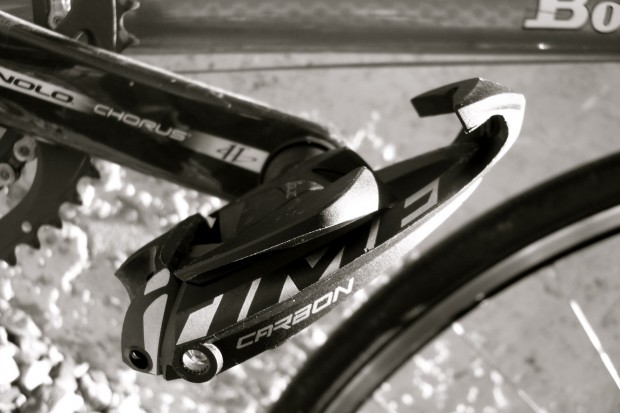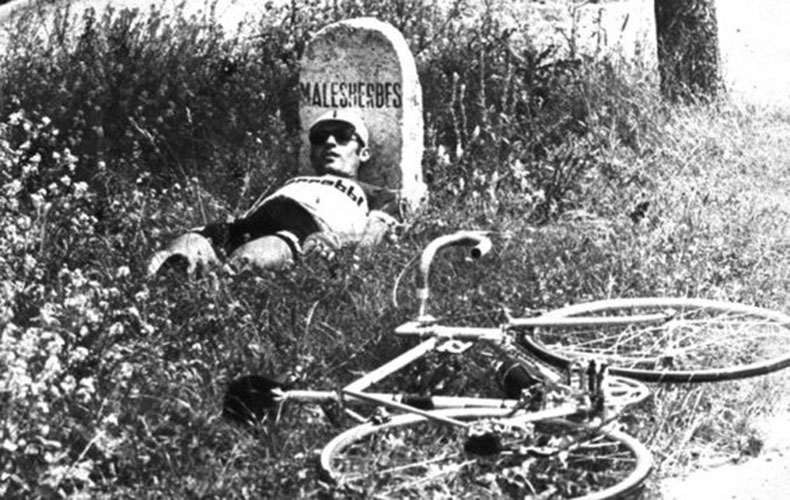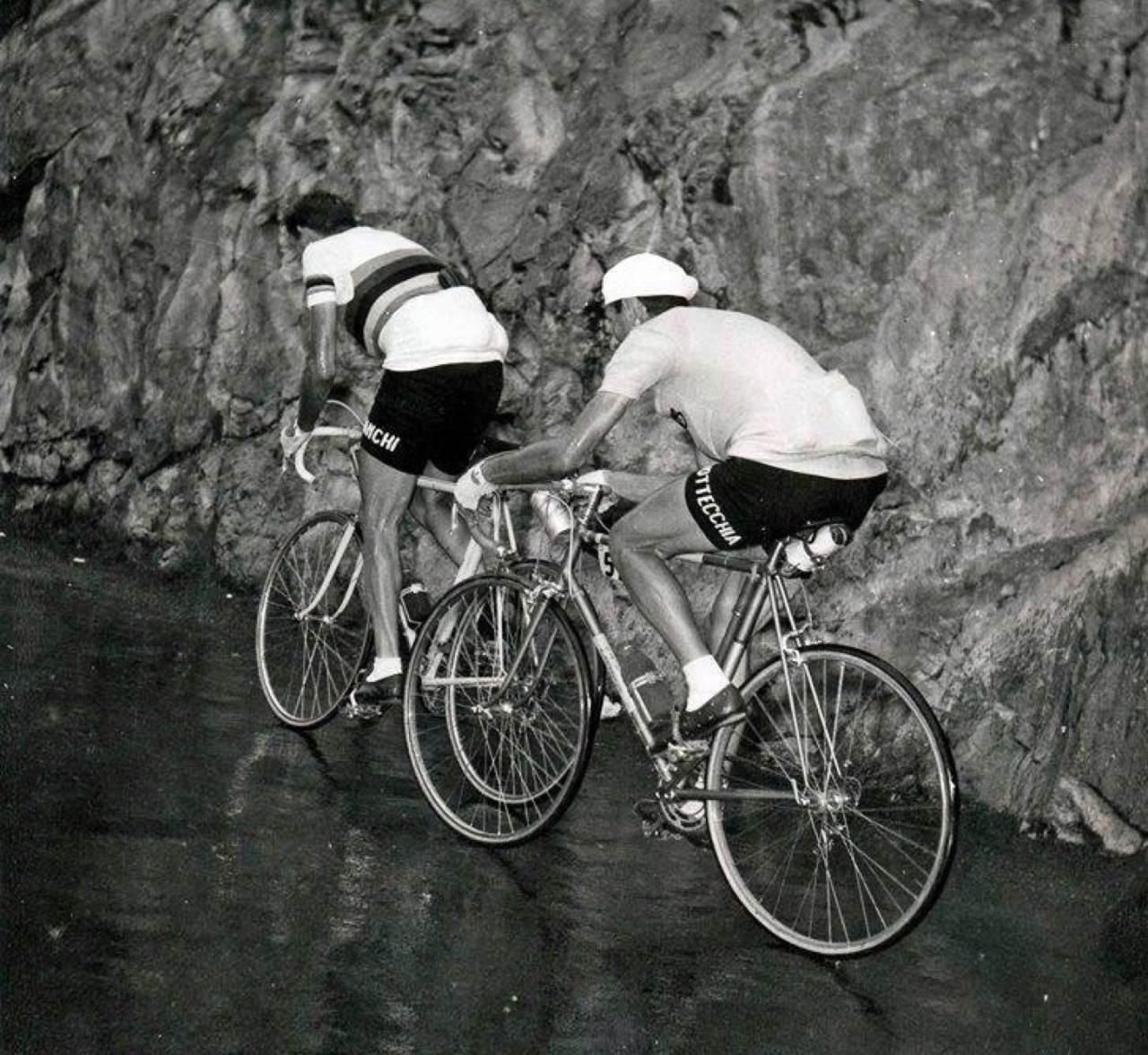Reverence: Time iCLIC Pedals

If you’ve ever sold bikes for a living, (or even just ridden them), you’ll know that the biggest fear of the newbie, or the moderately experienced cyclist is clipping in. It can strike the Fear of Merckx into the brawniest of men and reduce them to a quivering mess, saying things like “I don’t want to fall over”, “how will I get out if I need to walk up a hill” (hopefully only uttered by mountain bikers) or “I’ll look like a dick if I fall over at the traffic lights.” But as most of you here will attest, it’s happened to the best of us. It’s all part of the learning curve, a curve so shallow and rapidly transient that it’s probably best described as a slightly bent line. The mere act of clipping in quickly becomes second nature, as instinctive as flicking an Ergo, STI or DoubleTap lever to change gear, or reaching down to grab a bottle without taking your gaze from the road ahead.
My own initiation into the world of clipless was in 1991, a year or so after I started mountain biking. Up until then it had been a world of toe clips and straps, which while not exactly easy to get into or out of, was still a better alternative than muddy sneakers slipping off the pedals and gouging six-inch trenches of skin from your shins. Shimano had just released their first attempt at the SPD system (the M737?), and seeing local trend-setter Burgo rocking them with the sweet matching shoes was like witnessing the moon landing; it was right there in front of you, but you didn’t quite know if such a marvel of technology was possible. But it was, and soon a spate of ‘clip-ins’ were appearing from several other brands, including the now long-defunct Onza. Their HO pedal was smaller and lighter than Shimano’s, so it got my vote on those counts alone. It used two elastomer bumpers (similar to those being used in the suspension forks of the day) instead of steel springs for their retention force. You want more retention? Rebuild them with harder durometer bumpers. They were universally considered a pain in the ass to set up, and even more so to get in and out of as I quickly found out.
The Onzas were ditched after maybe a year or less of service, and the only way to go (according to the magazine reviews, and more importantly, advertising) was the Time ATAC. They were lauded as the easiest entry/ release, cleared mud better than Shimano due to their open body design, and were being ridden to victory in just about every World Cup race by the likes of Little Mig Martinez and a young Cuddles. They were a revelation in my clipless experience, and now on my third pair I won’t be changing anytine soon. I still have those original grey ATACs kicking around on my commuter bike, and apart from a tiny amount of bearing slop and some cosmetic gouging from the cleats, are still working flawlessly.
When I bought my first ‘real’ road bike, a steel Gipiemme, the shop set me up with some basic Look pedals, but with Time shoes. Both sucked. It wasn’t long before I’d replaced both, the Looks with a set of alloy-bodied Time Impacts, and the shoes with Sidis. (Still got both, although I’m buggered if I can find the pedals.) A set of RSX Carbons kept the Time-line going, more to reduce weight than for any operational advanatge. The only problem I’ve had has been the left cleat wearing prematurely (from putting the foot down and straddling the top tube Casually Deliberatley at lights) which can make entry a tad frustrating if you don’t get it right the first attempt. And at about $70 a set, replacing them regularly becomes not only a chore but a drain on a poor bike-shop guy’s wallet. Pulling away from a coffee stop on a ride, flailing left foot struggling to engage, slipping off and making a bloodied gouge in my knee warmer was all I needed to convince me to check out Time’s latest system, the iClic.
Now, it seems if you want to make a product sound hip and cool, just take the name of said product and stick an “i” in front of it. So no kudos to Time’s marketing team there, but I guess they took the easy option and one that’s easy to remember because of it’s genericity. All that aside, the promise of piece-of-piss-easy entry was too hard to resist, and when a customer wanted a set ordered, I thought I’d give them a try too. Dan at Sola Sports was singing their praises too, and hooked me up with a set of Carbons at the Velominati Special Deal rate. Cheers Dan!
It took, oh, about ten seconds to declare these the easiest pedals ever to get into. It was like my foot had been magically or magnetically drawn to the exact position for the cleat to engage, the pedal falling at the optimum angle, and the most satisfying ‘clic’ that I’d heard since those very first ATACs converted me for life. If you don’t know how the iClics work, think about ski boots/bindings. (I have never ski’ed, so if it all sounds like bullshit then it probably is.) The secret is in the Carbo-Flex plate under the pedal’s platform, which holds the retention mechanism open when you twist the shoe out. When it’s time to clip back in, the spring is in open position, allowing the cleat to locate with minimum resistance.
And as the Gestapo would tell you, resistance is futile.


OK..shimano original dura-ace spd road pedals (that us the same sized cleat as MTB pedals) circa 1994…I need a Velominati ruling.
They are fine as long as they colour match your Silca pump.
@velociphant
And, I’m assuming, your matching 1993 Motorola Merckx.
@Oli
+1
This could be considered bragging…and of course is a flagrant abuse of Rule #58…but I’m a little excited cos I’ve just snaffled a pair of the Carbon I-Clic’s for, as near as makes no difference, $100 via Ebay!!!
3 days postage & those pups are on the bike :)
My first foray into riding attached was on my first proper bike, my pride and joy, my Univega Supra Sport $200 job from KMart, received on my 13th birthday. I vividly recall taking a dive on that while cutting laps in the local undercover car park (read no road-cleaning rain) when I hit a patch of oil and dirt at speed mid-turn. I’m quite certain that my ability to remove myself from my straps wasn’t the issue, and at that speed I question how helpful it would have been anyway. But, what I look back at in wonder is the fact that as I slid along on my right side headed fast towards that breeze block wall all I was concerned with was keeping my steed off the deck. I had grazes all over me, but managed to hold my bike up off the ground until we slid to a halt. I wonder if I’d be so gentle now.
As far as the transition from those goes, I progressed to a mountain bike with toestraps, then bought the first Shimano SPD shoes (those shots have brought back some great memories) but persisited with straps. I finally bought a second-hand pair of SPD pedals off a mate when I had some spare cash between shouts at the uni bar, and never looked back. Fitted them that day at the bike racks. Rode home and had a near-miss at the lights when I tried pulling back. Foot down just in the nick of time. Face saved.
Now ride Time on road and Shimano off and can’t see myself changing.
I thought everyone had the “standard” first fall when switching to clip-in pedals – seems the most effective way to train muscle memory. I’ve had standard plus one. The standard fall came the first day on my new bike at the time and the first time I was using clip-ins. Was behind an experienced cycling friend, we came up a hill, he came to a full stop because of pedestrians. I came to a full fall in front of pedestrians.
The plus one was a year later. I was fully at home in the pedals. Everything was second nature. I was approaching a railroad track crossing and stop light, unclipped the left foot, and coasted up to a stop. I went to put my left foot down, at which time I realized that maybe everything was too second nature. As my left foot traveled down to the pavement, it clipped back into the pedal without me even thinking about it. The shock of my foot no longer traveling downward tipped me over onto those hard “square” rocks that line newly repaired railroad tracks. Ripped jersey, cut shoulder, bruised pride, and a line of cars now moving forward laughing at my clown act.
@Mikael Liddy
After a month’s extensive testing (as well as a month off the bike eyeing the beautiful new pedals & wishing I could ride) I’m happy to say these will be on any bike I own in the foreseeable future.
They are simply, fucking awesome!
I’ve found the non-carbon 2011 iClics on a great closeout sale, but my current pedals operate just fine and purchasing these may just get me in a wee bit of hot water with the VMH.
I’m looking for a valid excuse to pull the trigger (or maybe someone to talk me down off the ledge). Is clipping in really going to be a quantum leap above and beyond my current look-style pedals?
I’m just going to throw this out there, but I think a lot of issues with pedals and clipping in/out stem from the type of shoe used. Let’s face it, not all shoe soles are the same – material (carbon, nylon, mix, plastic) and not all are perfectly flat. Some have a ridge down the middle, some are gently curved, some are flat. I have bog-standard Performance pedals on all my three main road bikes and use various models of Diadora shoes. Some engage great, some a bit loose, some tight. The cleats are the same, the pedals are the same so it must be the shape of the sole. I think some folks are often quick to blame the pedal for causing difficulty in engaging/exiting, but the shoe/pedal compatibility must be considered too.
I was late to the Time party. I rode Look for a very long time, mostly because I felt some sort of allegiance to the pedal that made converts of Lemond and Hinault. There is an inherent flaw to the retention mechanism of Look-style pedals, though. The retention mechanism is not independent of the release mechanism. On my first set of Look pedals, I was able to actually pull out of the pedal in some instances. When I upgrade to the classically cool Look Carbo Pros, I wasn’t able to do that anymore, but it didn’t change the fact that at during a rather large part of the pedal stroke, you’re putting energy into compressing the retention spring instead of turning the crank.
When I finally made the jump to the Time Impact system, I noticed a few things almost immediately. The independent retention system is rock solid, the float was much more adjustable and free, and the stack height was greatly reduced. I didn’t think that stack height would make a huge difference, but it does! You can lower your saddle, lower your center of gravity, and I noticed improved foot stability. Imagine pedaling with six inch cleats and the energy it would take to stabilize your foot…
I now ride the Time iClic, and I agree with this article completely. They are my favorite so far. I know that Speedplay offer a greater degree of customizability, but I just cant get over the retention mechanism being on my shoe.
@Calmante
Dammit. I have no choice. I’m just gonna have to get them.
@The Oracle
Yup, they are the ducks nuts as our esteemed leader would say.
@The Oracle
Performance has a couple of styles currently on sale. I wouldn’t say they are banging deals, but they aren’t bad.
Are we able to revere these yet? It’s a bit soon isn’t it, they haven’t been superceeded yet.
@Tartan1749
I picked up a set of 2011 iclic Racers over at Competitive Cyclist for a pretty decent price. You can find the older versions on sale everywhere, because Time has released an improved version for 2012 to respond to some common complaints with the original design–redesigned cleats and a metal plate on the platform area to reduce wear. Even with shipping, Comp. Cyclist comes in about 15-20 dollars lower than even ebay prices right now. I should have them installed in time for my Saturday group trainer sufferfest, so I’ll let you all know my first impressions.
@Jarvis
I read somewhere that the only official criterion is that they product has been used (and adored) for six months or more.
I had one (iClic 2) fail on me during a race last month. Started to feel like a geriatric mushing on some pasta. Took an excessive amount of force to unclip, and the (new and improved) contact surface went flying off into the nether. Was able to clip in, but had now had two-dimensional float. I never really liked them much anyways, lots of half clips and a general vagueness about them. Cleats broke after 6 months, and new ones wear really quickly leading to aforementioned vagueness. Switched them out for Speedplays now.
@minion
I’m late to the game… but such a nice picture. I’m still on these on my #2 bike. Used Keywin since 1997 or soo. Still think they are better than the Shimanos and the different Look pedals I had.(never tried speedplay)
They are light, about 190 gr/pair with titanium axles which in 1998 was very light. There are others now, but weight including clip weight is still very good. The stack height is more or less nothing which I think is also an advantage. The clips(or plastic plates) are crap if you walk on them. I’m on my last set now, so probably shift to Look when they’re done.